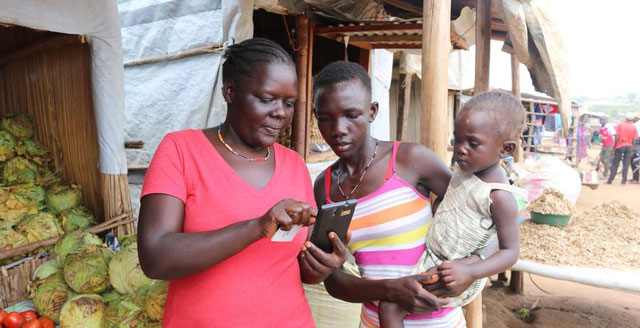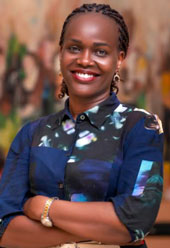
The majority of financially excluded women are in the informal sector and hard-to-reach areas, which requires innovative financing solutions to reach out to them – innovations in digital financial inclusion with a special focus on women is, therefore, necessary to improve the financial inclusion standing of the women
COMMENT | PATRICIA OJANGOLE | Over the years, financial inclusion has emerged as one of the key drivers of inclusive socio-economic development especially in developing countries. The human development discourse is therefore incomplete without addressing issues of financial inclusion. This is because creating an adequate level of financial inclusion enables individuals and entities to fully participate in the national economy.
Specifically, financial inclusion, or an inclusive financial market, especially in digitized form, reduces inequality by facilitating consumption, payments and money transfers, business operations as well as realizing benefits from financial products such as savings and credit. Financial inclusion also promotes the growth of innovative enterprises that can create employment. More importantly, financial inclusion offers a pathway to inclusive economic growth and development because it bolsters active participation and ultimately the economic empowerment of socially disadvantaged populations such as women and youth in the economy. It is therefore a tool for driving general social and economic inclusion.
It is proven that financial inclusion of women is key for household welfare improvement and/or poverty reduction. Female controlled finances or earnings are more likely utilized on household needs such as utilities and food, child welfare especially school fees and health care, as opposed to male earnings. It leads to financial security of women, which resultantly empowers them economically as well as in household decision-making processes.
The potential of financial inclusion in catalyzing equitable growth and development notwithstanding, financial deepening is still weak in Uganda, hence a significant proportion of the population is financially excluded. According to the latest FinScope data, less than 15 percent of Ugandan adults are financially included (by way of using banking services) and of these, only 9 percent have bank accounts – this is less than half of the Sub-Saharan African average of the financially included adults. This signifies that the extent of financial exclusion is huge in the country. The FinScope data signals that women are disproportionately financially excluded. The financially included or banked Ugandans are more likely to be male than female – Uganda’s gender distribution statistics of financially included or banked Ugandan adults confirm this, as 54% comprises men and 46% are women. Further, of the banked adults, close to 60% of the males save compared to only 42% of females, and this is like the borrowing behavior of the banked male and female adults.
Similarly, in the digital financial space, women are associated with a higher extent of financial exclusion. For example, according to the National Financial Inclusion strategy, women are less likely to own and use digital financial devices and services. The use of mobile money is lower among women (25%) compared to men (38%). The women are also more disadvantaged and are less likely to own accounts and make digitized transactions, save or borrow money and comprehend financial services. There is therefore a persistent gender gap in both digital and non-digital financial inclusion in Uganda, and this applies to the rest of Sub-Saharan Africa as well. It also derails economic development at both national and continental level, because financial exclusion is a deprivation of access to the financial system and the benefits therein for the women and other disadvantaged segments of the population.
The majority of financially excluded women are in the informal sector and hard-to-reach areas, which requires innovative financing solutions to reach out to them – innovations in digital financial inclusion with a special focus on women is, therefore, necessary to improve the financial inclusion standing of the women. The optimism to financially include women is high though – existing data show that it is feasible to have more women financially included. Indeed, of the unbanked Ugandan adults, women are more bankable (59%) compared to men (only 41% of the unbanked men are bankable).
Financial technology (Fintech) is one of the key innovations that is well-placed to drive financial inclusion through the provision of digital financial services. Today, the Fintech revolution is shaping the economic and financial landscape in the entire world. Gender mainstreaming in Fintech is key in driving digital financial inclusion of women.
Specifically, Uganda Development Bank (UDB), which is mandated with the socio-economic development of Uganda, has various interventions (both digital and traditional) to promote gender equity in financial inclusion and pave the way to women’s financial inclusion and economic empowerment.
UDB has partnered with Fintechs like Ensibuuko, to avail short term seasonal loans to small-holder farmers in upcountry areas with financing needs as low as UGX 50,000. The application, approval and disbursement processes are all done digitally with the funds moving direct to the farmers e-mobile wallet. The fintech solution is targeted at disseminating credit to the mass lower underserved market.
The digital initiatives are blended with traditional options like the UDB Women Prosper Loan – a product specifically tailored for women to increase access to affordable and appropriate financial services for women-owned and women-led businesses as an enabler to increased participation of women in the development agenda.
For the sustainability of the product, UDB understood that for a seamless inclusion process, the application process had to be simplified and directly respond to women needs in Uganda. The Women Prosper loans are accessed at an affordable rate of 10%-12% per annum and women can access a minimum of Shs100 million and a maximum of Shs900 million to boost their businesses.
More importantly, the application process has been abridged for this special category and enhanced with other benefits for example the Bank supports the purchase, surveying, and titling of land as a component of the main project cost.
Going forward, UDB is committed to supporting digital financial inclusion initiatives that encourage increased and active participation of women in the economy, by delivering innovative products and nurturing digital financial behavior to ensure that the benefits of the digital age in the financial market are equally shared, hence reducing overall as well as gender digital financial inclusion gaps.
As the world celebrates Women’s Day today, empowering women economically remains key for sustainable development and improved livelihood of Ugandans.
*****
 The writer is the Managing Director at Uganda Development Bank
The writer is the Managing Director at Uganda Development Bank
 The Independent Uganda: You get the Truth we Pay the Price
The Independent Uganda: You get the Truth we Pay the Price



